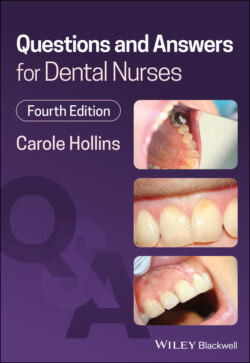Читать книгу Questions and Answers for Dental Nurses - Carole Hollins - Страница 10
Topic: Head and neck anatomy
ОглавлениеFor each of the following head and neck anatomy questions, select the single most appropriate answer from the option list. Each option might be used once, more than once or not at all.
1 External carotid artery
2 Glossopharyngeal nerve
3 Internal carotid artery
4 Long buccal nerve
5 Medial pterygoid
6 Occipital bone
7 Temporal bone
8 Temporalis
9 Trigeminal nerve
1 The muscles of mastication are those running between the skull and the mandible that are responsible for closing the mouth and chewing movements. Which one of the options listed is the muscle of mastication that has a point of insertion on the coronoid process of the mandible and acts to pull this jaw backwards and closed?
The correct answer is h).Temporalis runs from the temporal bone on the side of the head, under the zygomatic arch and inserts onto the coronoid process. It can be seen bulging in the temple region when the teeth are clenched together.
1 The nerve supply to the head is extensive and supplied by the 12 pairs of cranial nerves, which leave the brain directly through the base of the skull to innervate the area. Which one of the options listed is the name of the fifth cranial nerve that supplies the majority of structures in the oral cavity?
The correct answer is i).The trigeminal nerve is the cranial nerve of most importance to the dental team, and it splits into three divisions: the ophthalmic, the maxillary and the mandibular. The mandibular division is a combination nerve as it carries both sensory and motor components.
1 The major arteries carrying oxygenated blood to the head and neck region are the common carotid arteries, which are direct branches from the arch of the aorta as it leaves the left ventricle. Which one of the options listed is the branch of the common carotid artery that supplies this oxygenated blood to the face and oral cavity?
The correct answer is a).The common carotid artery divides into two branches in the upper neck area; the external carotid artery, which runs outside the cranium and supplies the face and oral cavity, and the internal carotid artery, which passes into the brain and supplies it and some of the sensory organs, such as the eyes.
